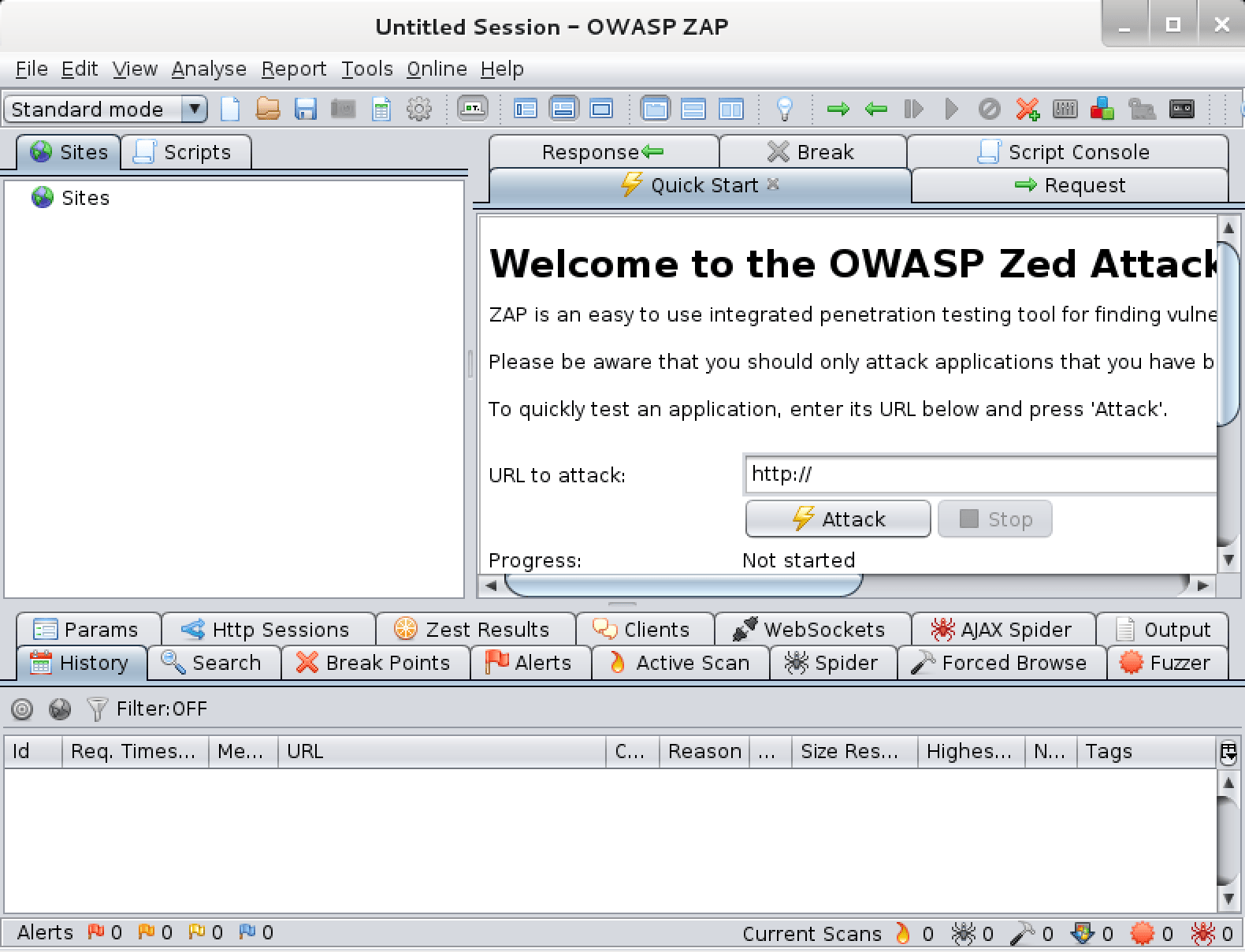Tool Documentation:
Screenshots
Packages and Binaries:
zaproxy
The OWASP Zed Attack Proxy (ZAP) is an easy to use integrated penetration testing tool for finding vulnerabilities in web applications.
It is designed to be used by people with a wide range of security experience and as such is ideal for developers and functional testers who are new to penetration testing as well as being a useful addition to an experienced pen testers toolbox.
Installed size: 258.00 MB
How to install: sudo apt install zaproxy
Dependencies:
- default-jre
owasp-zap
root@kali:~# owasp-zap -h
Found Java version 21.0.7
Available memory: 7946 MB
Using JVM args: -Xmx1986m
Usage:
zap.sh [Options]
Core options:
-version Reports the ZAP version
-cmd Run inline (exits when command line options complete)
-daemon Starts ZAP in daemon mode, i.e. without a UI
-config <kvpair> Overrides the specified key=value pair in the configuration file
-configfile <path> Overrides the key=value pairs with those in the specified properties file
-dir <dir> Uses the specified directory instead of the default one
-installdir <dir> Overrides the code that detects where ZAP has been installed with the specified directory
-h Shows all of the command line options available, including those added by add-ons
-help The same as -h
-newsession <path> Creates a new session at the given location
-session <path> Opens the given session after starting ZAP
-lowmem Use the database instead of memory as much as possible - this is still experimental
-experimentaldb Use the experimental generic database code, which is not surprisingly also still experimental
-nostdout Disables the default logging through standard output
-loglevel <level> Sets the log level, overriding the values specified in the log4j2.properties file in the home directory
-sbomzip <path> Creates a zip file containing all of the available SBOMs
-suppinfo Reports support info to the command line and exits
-silent Ensures ZAP does not make any unsolicited requests, including check for updates
Add-on options:
-postmanfile <path> Imports a Postman collection from the specified file name.
-postmanurl <url> Imports a Postman collection from the specified URL.
-postmanendpointurl <url> The endpoint URL, to override the base URLs present in the Postman collection.
-certload <path> Loads the Root CA certificate from the specified file name
-certpubdump <path> Dumps the Root CA public certificate into the specified file name, this is suitable for importing into browsers
-certfulldump <path> Dumps the Root CA full certificate (including the private key) into the specified file name, this is suitable for importing into ZAP
-host <host> Overrides the host of the main proxy, specified in the configuration file
-port <port> Overrides the port of the main proxy, specified in the configuration file
-hud Launches a browser configured to proxy through ZAP with the HUD enabled, for use in daemon mode
-hudurl <url> Launches a browser as per the -hud option with the specified URL
-hudbrowser <browser> Launches a browser as per the -hud option with the specified browser, supported options: Chrome, Firefox by default Firefox
-openapifile <path> Imports an OpenAPI definition from the specified file name
-openapiurl <url> Imports an OpenAPI definition from the specified URL
-openapitargeturl <url> The Target URL, to override the server URL present in the OpenAPI definition. Refer to the help for supported format.
-autorun <source> Run the automation jobs specified in the file or from the URL
-autogenmin <filename> Generate template automation file with the key parameters
-autogenmax <filename> Generate template automation file with all parameters
-autogenconf <filename> Generate template automation file using the current configuration
-graphqlfile <path> Imports a GraphQL Schema from a File
-graphqlurl <url> Imports a GraphQL Schema from a URL
-graphqlendurl <url> Sets the Endpoint URL
-addoninstall <addOnId> Installs the add-on with specified ID from the ZAP Marketplace
-addoninstallall Install all available add-ons from the ZAP Marketplace
-addonuninstall <addOnId> Uninstalls the Add-on with specified ID
-addonupdate Update all changed add-ons from the ZAP Marketplace
-addonlist List all of the installed add-ons
-notel Turns off telemetry calls
-script <script> Run the specified script from commandline or load in GUI
-quickurl <target url> The URL to attack, e.g. http://www.example.com
-quickout <filename> The file to write the HTML/JSON/MD/XML results to (based on the file extension)
-quickprogress: Display progress bars while scanning
-zapit <target url> The URL to perform a quick 'reconnaissance' scan on, e.g. http://www.example.com The -cmd option must be specified
zaproxy
root@kali:~# zaproxy -h
Found Java version 21.0.7
Available memory: 7946 MB
Using JVM args: -Xmx1986m
Updated on: 2025-May-30
